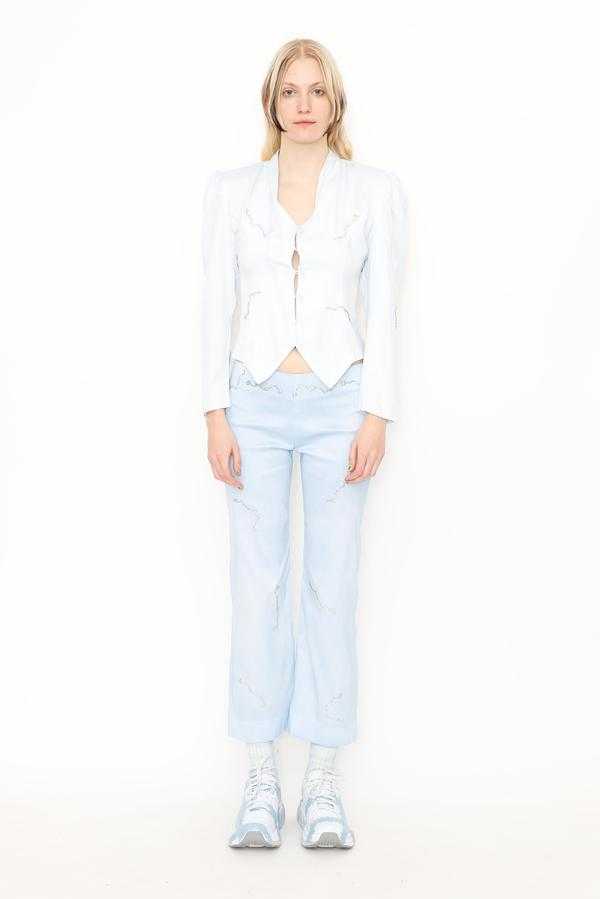On Fashion and Disability
-
The image above is of model Aaron Philip, decked out in Collina Strada SS21. Collina Strada is one of the few fashion brands thus far to cast people with visible disabilities in their runway shows. I love the brand because of its clothing and appreciate their actions in commitment to diversity, antiracism, and climate change awareness, however, there's something interesting/disorienting about seeing the handful of models with disabilities mingling with the seemingly able-bodied, rail thin majority of the models that bound up and down the catwalk energetically.
I used to be able-bodied and now I am not. I am white and my disabilities aren't as forthcoming as some people's. My experience of fashion intersecting with disability is heavily informed by these facts and I absolutely am open to critical feedback from other people with disabilities who have had experiences different from mine.
My body hurts almost all the time. It hurts to drive a car, it hurts to work on the computer, it hurts to knit a scarf, it hurts to get dressed. When I gear up to take pictures for Mold Fashioned, I get a pit of apprehension in my stomach in preparation for the pain of raising my arms, finagling sleeves, bending over to tie my shoes. I almost always immediately change back into sweats after taking a photo, as I don't need to compound the inescapable discomfort with the icky feeling of too many layers or a too-tight bodice (I also have autism, which exacerbates this, and which I'll hopefully write a post about i/r/t fashion soon!).
It would be much simpler if I had a "capsule collection" of caftans and sweatsuits that I rotated daily. It doesn't make sense that I have a fashion blog. I am increasingly uncomfortable in my own body, and stuffing myself into puffy-sleeved ballgowns or itchy wool sweaters seems self-defeating. Yet something about purchasing "interesting" clothes and getting dressed up in them compells me to do it again and again.
Esme Weijun Wang, one of my inspirations in both the realm of fashion and of living with debilitating conditions, feels a similar compulsion, writing "I still buy dresses from online vintage shops for no occasions in particular... I have an entire wardrobe for that other, healthier life. They await my return." Is that what attracts me to fashion? The same aspiration fashion marketers use to sell clothes to able-bodied people, heightened by my inability to fully believe in the reality of my pain and my desire to not only have the body and transcendent glory of the consummate model but to have their wellness, too?
Collina Strada attempts to reject this narrative by including non-average models in the aspirational world they create. However, the brand's largely online presence invites a layer of mediation that minimizes the physical realities of debilitating conditions. In projects such as a series of video games and a virtual fashion show, both set in the fantastical "Collina Land," models such as Philips glide over digital obstacles, swerve through the air, and hop around lush landscapes with ease, set to a chipper electro-pop soundtrack. However well-intentioned all involved are (and I believe they are), this digital delivery of the optics of disability unavoidably aestheticize them and divorce them from what might be a difficult or painful corporeality much of the time.
I don't think it's necessarily bad to incorporate disability into fantasy, to romanticize it (if done by disabled people, not able-bodied people just trying to exploit an inclusivity trend), to include disability in the image of a desirable life. I think that's necessary in order to create a world in which disability is more than abjection and is justified in and of itself as deserving attention and care. But when that world-building is combined with fashion merchandizing, the insidiousness of aspiration rears up again: I want to be THAT kind of disabled, the kind that is painless and expansive and, of course, decked out in $400 Collina bodysuits.
Whereas mediums such as movies and TV offer the chance for disability to be explored with nuance (though it often isn't), fashion leaves little room for nuance - at the end of the day, the clothes need to be sold. This is especially evident if you look at the discrepancy between the relative diversity displayed at the Collina Strada shows versus the models on their website who are tall and thin and virtually all present as able-bodied.
I'm going to keep thinking about different ways I can relate disability to fashion, as I'm not satisfied with the aspiration model as my only option. If you have a disability or debilitating chronic condition and have any thoughts on this, please reach out under the "Contact" tab above. I'd love to think of something better with you.
